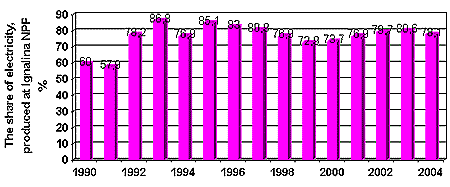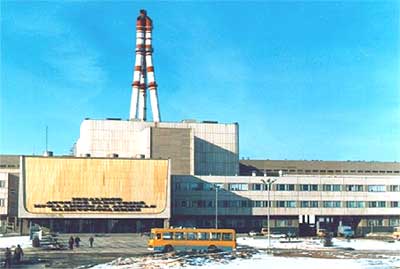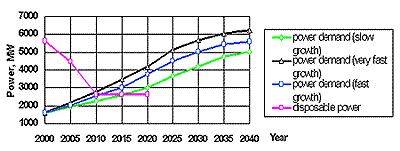
LITHUANIA MADE A STEP OUT FROM NUCLEAR BUSINESS.
WHAT WILL BE THE NEXT STEP?
Jonas Gylys, Chairman of LNEA
Stanislovas Ziedelis, Secretary General of LNEA
Lithuania is a relatively small country with
only 3.5 million inhabitants. At present, Lithuania is a state
with powerful energy industry and low energy consumption. Up to
end of 2004 our energy plants could produce three times more electricity
than it is necessary for our internal needs. Installed electricity
generating capacities were more than 6.2 GW. Since 1990 the total
power demand decreased to less than 2GW and the total electricity
consumption decreased to less than 8.3 TWh. At the same time,
Lithuania has one of the last places in Europe according to electricity
consumption per capita: in 2002 it was around 2900 kWh of electrical
energy on average per capita. During the last few years the economy
of Lithuania had been growing very fast: in 2002 gross national
product grew up 6.8%, and in 2003 – 9.0%.
The energy sector of Lithuania is strongly based
on the nuclear energy. From 60% to more than 86 % of electricity
each year is produced by our single nuclear power plant –
Ignalina NPP with its two RBMK-1500 type reactors (see Fig. 1).
Comparing the share of nuclear in total energy production it becomes
apparent, that Lithuania and France are the two countries in the
world where this parameter is close to 80 percent. Comparison
of the share of different kinds of primary energy sources used
in Lithuania for different branches of economy also shows high
importance of nuclear fuel: it covers about one third (32 –
37%) of the whole consumption volume alongside with oil (31 -
33%) and natural gas (30 - 31%).

Fig. 1. The share of electricity produced at Ignalina
NPP in total electric energy production of Lithuania
Thirteen RBMK reactors are being operated in
Russia and in Lithuania at the present moment. The RBMK-1500 reactor
of Ignalina NPP is the most advanced version of the channel type
reactor design series of the former Soviet Union. Only two reactors
of this type were built and both of them at the Ignalina site.
The designed power of the RBMK-1500 reactor (1500 MW electrical,
4800 MW thermal) is the biggest in the world for a single unit.
The first unit of INPP was put into operation by the end of 1983
and the second unit – in 1987. The designed life time of
RBMK reactors is 30 years. After the Chernobyl accident the maximum
allowed power of each reactor at INPP was reduced to 1350 MW (electrical)
or 4200 MW (thermal). Since its commissioning the initial RBMK-1500
design of Ignalina NPP was substantially improved, and several
specific features of modern reactor design were implemented. More
than 200 million US dollars of western countries support were
spent for these purposes. The Safety Analysis Reports for both
units and the Reviews of these reports prepared by international
teams according to all Western safety requirements have shown
that the safety level of Ignalina NPP is very similar to the western
type NPPs of the same age.
During the Lithuania’s accession process
into the EU, one of the main EU requirements to the energy sector
of Lithuania was to close both reactors of Ignalina NPP. This
requirement of the EU authorities was not changed during the accession
negotiations despite all explanations made by experts on the differences
between Ignalina and Chernobyl reactors, numerous safety improvement
measures implemented, positive results of safety studies and assessments.
Realization of this requirement started in December 31, 2004,
when the 1st reactor of Ignalina NPP was shut down (see Fig.2).
Installed electricity-generating capacities in Lithuanian energy
system decreased to 4.9GW.

Fig.2. The 1st Unit of Ignalina NPP. Its reactor
will no longer produce electricity.
Ignalina NPP and energy sector of Lithuania were
prepared to this event. The decommissioning program of unit 1
and other relevant measures have been elaborated, safety analysis
reports for operating single unit 2 were prepared and reviewed.
The arrangements implemented should guarantee safe and effective
operation of the unit 2 of Ignalina NPP without serious hurt to
utilities. However, the end of 2009 foresees the shutdown of the
2nd reactor.
The main possible consequences of premature total
closure of Ignalina NPP can be classified into several groups,
but majority of them are negative.
-
The consequences to energy sector are essential.
Decreasing of total electricity-generating capacities together
with growing economy, energy consumption and power demand
can cause the negative power balance and energy shortage.
Depending on the rate of economy growth, such situation can
occur in 2015 – 2020 or even in 2010 at the case of
very fast economy growth (see Fig.3).

Fig.3. Forecast for power generation capacity
and power demand growth for slow, fast and very fast economy
growth scenarios, respectively
-
Negative impact to macroeconomics of Lithuania. Depending
on the rate of growth of energy needs, closure of Ignalina
NPP will cause the state payments deficit about 300 –
400 millions EURO.
-
Impact to environment. The portion of electricity generated
by Ignalina NPP will be replaced mainly by electricity produced
at gas-fired power plants, and this will significantly increase
the CO2 emissions. Lithuania signed the Kyoto Protocol
and undertook obligations to reduce the green house gas emissions
by 8% at 2008 – 2012 in respect to level of 1990. Another
obligation - not to exceed 5.2 mln tones of CO2
emissions per year. The existing Lithuanian thermal power
plants, operating on full power mode, will produce around
5.0 mln tones of CO2 per year. Despite the increasing
usage of renewable sources of energy, pursuance of this obligations
without nuclear seems to be not realistic.
-
Social consequences. Since the Ignalina
NPP is a single nuclear power plant in Lithuania, the major
part of its personnel after its closure will become unemployed
with limited possibilities for changing speciality and residence.
-
Reliability of energy supply. Both natural
gas and oil for thermal power plants are imported to Lithuania
from a single source, which is Russia (via Belarus). After
closure of Ignalina NPP and taking into account the EU prohibition
for burning heavy oil with sulphur content more than 1% in
power industry, the main primary energy source for Lithuania’s
energy sector will be a natural gas, and its share will be
up to 80%. Such level of dependence on the prices and reliability
of supply from single source seems to be potentially dangerous.
The above-mentioned problem is analysed in the report of the
Centre of Strategical Investigations of Lithuania. It is stated
in this document, “Lithuania’s dependence on the
import of energy sources from Russia can be evaluated as real
threat not only for economy, but also for national security
and political independence”.
-
Impact to education and knowledge. Popularity
of nuclear engineering sciences and numbers of students studying
these sciences are decreasing, and lack of motivation to work
in the nuclear energy sector is observable. Current trends
lead to gradual degradation of nuclear knowledge system of
Lithuania.
Trying to find an optimal solution for future
development of Lithuania’s energy sector, the several feasibility
studies of new nuclear power plant were performed. The results
obtained from these studies show at what conditions construction
of a new nuclear plant is economically reasonable. It is demonstrated
that new nuclear power plant is competitive and even more favourable
option in respect to combined cycle gas turbine power plant, if
price of natural gas during period 2005 – 2020 will increase
more than 20% in respect to nowadays price level.
Like in other countries, some Lithuanian people
would like to use cheap electricity, generated only from renewable
sources. However, in the nearest future it is impossible: reasonable
solution of the above mentioned problems and limitation of growth
of prices of electricity is possible only using all technological
options of energy generation, including nuclear. In Lithuanian
newspapers and on TV are sometimes published articles and reports
about threats, related with storage of spent nuclear fuel and
radioactive waste, and other well-known anti-nukes’ arguments.
Despite this tendentious information, initiated by gas and oil
lobby, the public opinion remains positive in regard to nuclear:
majority of Lithuanian people has nothing against new, modern
and safe western type nuclear power plant, if it will produce
cheaper electricity.
The Lithuanian National Energy Strategy (2002)
affirms that in the future Lithuania can remain a nuclear state.
This approach was confirmed in the last year by the Government
of Lithuania approving “The Government Program for period
2004-2008”. It is planned in this program:
Taking into account these declarations of Government
it is possible to expect, that the next step of Lithuania in the
area of future energy supply will be towards continuation of nuclear
energy usage, and this step will express the decision about construction
of new nuclear power plant.
|









